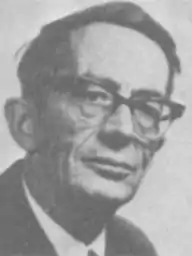Wacław Gajewski
Wacław Gajewski (28 Februari 1911 – 12 December 1997) was a Polish geneticist, one of the founders of the Polish post-war genetics and author of numerous academic and popular scientific books.
Wacław Gajewski | |
|---|---|
 | |
| Born | 28 February 1911 |
| Died | 12 December 1997 (aged 86) |
| Nationality | Polish |
| Alma mater | Uniwersytet Warszawski |
| Known for | Work on Geum and fungal genetics; establishment of Polish genetics |
| Scientific career | |
| Fields | Genetics |
Biography
Gajewski was born in Kraków in 1911. Shortly after the war, in 1948 Gajewski was one of the few Polish biologists who opposed the official "new biology", lysenkoism—a pseudoscientific theory of genetics proposed by the Soviet agronomist Trofim Lysenko. Consequently, during the Stalinist period Gajewski was not allowed any contact with students; however, he was permitted to continue his scientific work.[1]
In 1956, with the end of Stalinism and the diminishing importance of lysenkoism, Gajewski was allowed to hold a position of lecturer at the Uniwersytet Warszawski, where two years later, the first Polish department of genetics was established under his leadership.
During the years 1967-1981 Gajewski was the director of the Institute of Biochemistry and Biophysics of the Polish Academy of Sciences. In 1981, when martial law was imposed in Poland, Gajewski (then retired) was initially on the list of Polish scientists that were to be arrested.
He died in Warsaw in 1997.
Scientific career
Gajewski first published in 1932. He soon became interested in cytogenetics and molecular genetics.
In the late 1940s and early 1950s, Gajewski worked on the genetics of the genus Geum.[2] Later, he published several acknowledged papers in the area of fungal genetics.[3]
References
- Gajewski W. (1990). "Lysenkoism in Poland". The Quarterly Review of Biology. 65 (4): 423–34. doi:10.1086/416949. PMID 2082404.
- Gajewski Wacław (1957). "A cytogenetic study on the genus Geum". Monogr. Bot. 4: 1–416.
- Perkins David (2003). "Wacslaw Gajewski, 1911-1997". Fungal Genetics Newsletter.